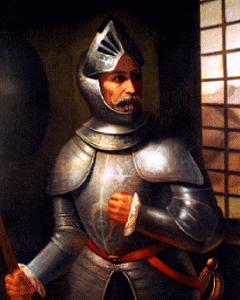Alonso García de Ramón facts for kids
Alonso García de Ramón was a Spanish soldier who became the leader (called a Royal Governor) of Chile two times. He was born in Cuenca, Spain, around 1552 and passed away on August 5, 1610. He first served as governor for a short time from July 1600 to February 1601. Later, he was governor again from March 1605 until August 1610.
Contents
Early Life as a Soldier
Alonso García de Ramón started his military career very young, at just 16 years old. He joined the Spanish Army and first fought in Granada against a rebellion.
He then served in Italy and Sicily. He was part of the navy led by Juan of Austria. He fought in the 1572 Battle of Navarino, which happened after the famous Battle of Lepanto. In 1574, he was stationed at Goleta during a campaign in Tunis. He also survived a battle in 1576 near the Kerkennah Islands.
Later, he went to Flanders (which is now parts of Belgium, Netherlands, and France). There, he served as a sergeant under Alexander Farnese, Duke of Parma. He took part in several important attacks, including the assault on Zichem and the attack on Borgerhout. He was also part of the siege of Maestricht. During this siege, he was one of the first soldiers to climb the city walls. He was wounded twice and managed to capture two enemy flags. For his bravery, the Duke rewarded him.
Military Service in Chile and Peru
After his time in Europe, Alonso García de Ramón returned to Spain. From there, he traveled to Chile. In Chile, he fought bravely against the Mapuche people alongside Governor Alonso de Sotomayor.
One of his most famous actions was during the siege of Purén. In a one-on-one fight on horseback, he defeated and killed the Mapuche leader, called a Toqui, named Cadeguala.
Soon after, a new governor named Martín García Óñez de Loyola took over in Chile. García de Ramón then moved to Peru. There, he gained the trust of the Viceroy of Peru, García Hurtado de Mendoza, 5th Marquis of Cañete. A Viceroy was like a king's representative in a large territory. The Viceroy gave him many important jobs, which he did very well. These jobs included being the "corregidor" (a local administrator) of Arica and Potosí.
By 1599, he was a top military advisor to the Viceroy, Luis de Velasco. He was known as the "Maestro de Campo" (a high-ranking military commander) for all of Peru.
First Time as Governor of Chile
Alonso García de Ramón was sent to Chile to take over as governor temporarily. He arrived in Chile on July 29, 1600, and became governor the very next day.
He quickly realized that the situation in southern Chile was much worse than he had thought. Many Spanish cities and forts were under attack or had been lost. For example, La Imperial had fallen in April.
Since he couldn't get more soldiers or supplies from Peru, he had to get them from the cities in Chile. He did this by asking for special taxes and taking cattle, horses, and weapons. This allowed him to quickly build an army of 400 well-equipped men by December 1600.
In early January, his army marched to Chillán. He had to leave some soldiers there to stop Mapuche attacks. He then moved to Concepcion. From there, he planned to help the remaining Spanish cities that were under siege, like Valdivia, Villarica, and Osorno.
He tried to send help by ship to Valdivia and Chiloé, but the ship was stolen by soldiers who ran away to Peru. Not giving up, he planned to march south through the central valley to help Villarrica and Osorno. However, he and his 310 men had not gone far when he heard that Arauco was now under siege. He turned back to help Arauco, but then he learned that Alonso de Ribera had arrived to become the new governor in February 1601. So, his first time as governor ended.
Second Time as Governor of Chile
Alonso García de Ramón was appointed governor of Chile again in 1605, replacing Alonso de Ribera. This time, he used the forts that his predecessor had built as bases for his military campaigns against the Mapuche.
In 1606, Spanish forces led by García de Ramón fought a large Mapuche army in the Battle of Boroa. About 500 Spanish soldiers defeated around 6,000 Mapuche warriors. After this victory, García de Ramón built a new fort called San Ignacio de la Redención near Boroa. However, this fort was soon abandoned after most of its soldiers were ambushed.
In 1607, García de Ramón rebuilt Fort Purén and another fort called San Jerónimo de Millapoa. But after an agreement known as the Parliament of Catirai, he soon took down the latter fort.
Sources
- José Toribio Medina, Diccionario biográfico colonial de Chile, Impr. Elziviriana, Santiago, 1906, Pg. 338 - 341 Alonso García de Ramón
- Diego Barros Arana, Historia general de Chile. Tomo tercero
- Capítulo XVII, Parts 7-9
- Capítulo XXI
- Capítulo XXII
| Government offices
|
||
|---|---|---|
| Preceded by Francisco de Quiñónez |
Royal Governor of Chile 1600–1601 |
Succeeded by Alonso de Ribera |
| Preceded by Alonso de Ribera |
Royal Governor of Chile 1605–1610 |
Succeeded by Luis Merlo de la Fuente |
See also
 In Spanish: Alonso García Ramón para niños
In Spanish: Alonso García Ramón para niños


